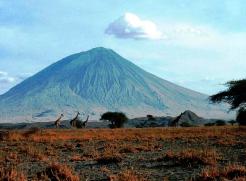Carbonatite Occurrences of the World

Alan R Woolley & Bruce A Kjarsgaard
Published by: Geological Survey of Canada: Open File 5796
Publication date: 2008
List Price: CD-Rom and paper map, Can$: 18.45 in Canada; Can$24.00 elsewhere. The package can be obtained free from http://geopub.nrcan.gc.ca/moreinfo_e.php?id=225115, but as the world map of occurrences measures 2 x 1 m, obtaining the hard copy map and CD-Rom is handier.
This production warrants a special review; it is quite the most extraordinary comprehensive world compilation, rather reminiscent of similar Russian productions. In this case, however, the authors come from the Natural History Museum in London and the Geological Survey of Canada. The product draws heavily on three books covering the alkaline rocks and carbonatites of the world; two by Alan Woolley1,2 and one by L N Kogarko and others, covering Russian occurrences.
The recognition of these unusual igneous rocks commenced with Högbom, in 1895, at Alnö, Sweden; Brögger, at Fen, Norway, in 1921; and Soëllner, at Kaiserstuhl, Germany, in 1927. Critics of their proposed igneous origin were numerous, including Bowen in 1924. Dixey, in 1937, described eleven more occurrences from Nyasaland (Malawi).
In 1953, I had no doubts about the igneous origin of carbonatite; for the largest of my five carbonatite complexes, Rangwa 4, on the shores of Lake Victoria, Kenya, was situated in the throat of a sixty-mile diameter, eroded Miocene volcano, Kisingiri, which had erupted nephelinite and melilitite lavas. The central carbonatite was surrounded by intrusive uncompahgrite (only the second recorded occurrence in the world) and ijolite; and, beyond, country rock of fenitised Precambrian granite.
Barry Dawson, during the same decade, described the extraordinary, thin natrocarbonatite flows in the crater of the active Ol Doinyo Lengai volcano, Tanzania. This new compilation lists no fewer than 527 occurrences throughout the world! It is an invaluable addition for those involved with the academic study of the processes that generate igneous rocks in the mantle, and also those involved with economic minerals.
The essential feature of this publication is the superb accompanying map, in hard copy, on a scale of approximately 1 to 19 million and measuring two by one metres; showing all the known, confirmed occurrences of carbonatites by a serial number, and listed by continent and marked with a symbol on the map. The greatest concentrations are found in Russia (71) and Canada (77), with noted clusters in the Kola Peninsula, the south of Hudson’s Bay and southern and eastern Africa (the latter along the rift valleys).
On the CD-Rom there is a suite of nine world maps, showing the magmatic association of the carbonatites (melilitite, nephelinite, basanite, phonolite, trachyte, kimberlite, lamprophyre, no associated silicate rocks, ultramafic cumulates). Seven maps show the age distribution, which ranges from Archaean to Recent and Active. Three world maps show those complexes that have been exploited for minerals, which include bastnäsite, monazite, apatite, pyrochlore, magnetite, fluorite, vermiculite, calcite, chalcopyrite, baddeleyite, thorite and uraninite. Phalaborwa in South Africa is unique in having a central copper sulphide body, as well as deposits of phosphate, vermiculite, iron, zirconia, thorium, uranium, nickel and nobel metals; and is a source of sulphuric acid. Niobium and vanadium are worked in the Kola Peninsula; niobium was worked for over many years at Oka, Canada; phosphate and iron are worked for in South West Africa and China; titanium is worked for in the USA.
The data headings in the database are: I D number; Location name; Alternative name; Continent; Country/State/Province/Territory; Latitude and Longitude; Carbonatite type; Magmatic style; Associated silicate rocks; Age; Age reference; Mineralisation; Woolley volume reference; Notes; General reference.
This is a magnificent and most useful publication. Perhaps next, someone can do the same for kimberlites, again with a very large hard-copy map of the world! Another possibility would be terrestrial impact structures. I have seen several of the Russian global compilations (indeed I prepared the English language version of one of them) but this database seems to me to set a new standard.
References
- Woolley, A.R 1987. The Alkaline Rocks and Carbonatites of the World. Part 1; North and South America. British Museum (Natural History) and University of Texas Press; 216 pp.
- Woolley, A.R 1987. The Alkaline Rocks and Carbonatites of the World. Part 3; Africa. Geological Society, London; 372 pp
- Kogarko, L.N., Kononova, V.A., Orlova, M.P, & Woolley, A.R. 1995. The Alkaline Rocks and Carbonatites of the World. Part 2. Former USSR. Chapman & Hall, London; 226 pp.
- McCall, G.J.H. 1958. Geology of the Gwasi Area. Geological Survey of Kenya. Report No. 45; 88 pp